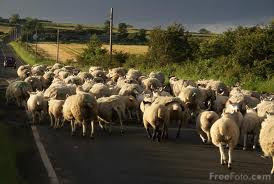The Oak
Young and old,
Like yon oak,
Bright in spring,
Living gold;
Summer-rich
Then; and then
Autumn-changed,
Soberer-hued
Gold again.
All his leaves
Fallen at length,
Look, he stands,
Trunk and bough,
Naked strength.
Alfred Lord Tennyson
I really enjoyed the simplicity of this poem. It has colorful imagery and I personally connected with it because I grew up in an valley that has many revered oak trees. My favorite verse is definitely the last one. I can really picture, though not a typically beautiful sight, a naked elderly grey-bodied man compared to a winter-bare-wrinkled-grey oak trunk, and see them as quite a pair. Even though, neither are at the most beautiful stages of their lives, you know that they have endured the joy and fight of life. The idea of "naked strength" to me is so compelling. To me, that simple line composed of two words, made me love and connect to the whole poem. That is a great lesson for me as a writer, sometimes clear and simple yet evocative communication can be best of all.
Interesting Facts About the Author
Alfred Lord Tennyson
 There was a lot of very valuable information within Alfred Lord Tennyson's biography on poemhunter.com, but here are a few tidbits that I really found interesting.
There was a lot of very valuable information within Alfred Lord Tennyson's biography on poemhunter.com, but here are a few tidbits that I really found interesting. Some of Tennyson's phrases have withstood the test of time and become commonplace in contemporary English language, such as "Tis better to have loved and lost / Than never to have loved at all." This phrase comes from Tennyson's In Memoriam A.H.H., which is a very long poem written to commemorate his late brother-in-law and friend Arthur Hallam. In Memoriam A.H.H. is considered to be Tennyson's lifelong masterpiece.
Tennyson began writing poetry at a very young age, inspired by other poets including John Keats. Tennyson published his first solo work while in college at Cambrige in 1827, entitled Poems by Two Brothers. He achieved early success with his first book, but his second book published in 1833, was not well received and discouraged Tennyson from publishing for 10 years! It is amazing what your inner "resistance" can keep you from accomplishing. Though he did still write during all those unpublished years.
In 1850, upon publishing his renowned In Memoriam A.H.H., Alfred Tennyson was appointed Poet Laureate which he held until his death in 1892. According to Wikipedia, the Poet Laureate is an "honorary position appointed by the monarch of the United Kingdom on the advice of the Prime Minister. The role does not entail any specific duties, but there is an expectation that the holder will write verse for significant national occasions." He became Baron Tennyson much later in 1884 as a result of Queen Victoria's admiration of his work. Thomas Edison was also one of Tennyson's admirers and made multiple sound recordings of Tennyson reading his own poetry.
Alfred Lord Tennyson's biography on poemhunter.com said that he was a master in onomatopoeia, alliteration and assonance. I thought that is may be helpful to define what those literary terms mean.
Helpful Vocabulary
Onomatopoeia - (n.) the formation of a word from a sound associated with what is named
ie. buzz, whoosh, screech, bang, hiss, puff, fizz
Alliteration - (n.) the occurrence of the same letter or sound at the beginning of adjacent or closely connected words.
ie. Jumping Jehosaphat!, ardent anarchist, icy igloo, mourning mother
Assonance - (n.) in poetry, the repetition of the sound of a vowel or diphthong in nonrhyming stressed syllables near enough to each other for the echo to be discernible
ie. Tonight I'll try to light your fire. (long "i" sound), And so she rests in her hammock, depressed tears wet her tresses and stain her dress (short "e" sound).
Alfred Lord Tennyson's Works:
Poems, Chiefly Lyrical (1830):
Lady Clara Vere de Vere (1832)
Poems (1833):
The Lady of Shalott (1832, 1842)
The Palace of Art
St. Simeon Stylites (1833)
Poems (1842):
The Two Voices (1834)
"Ulysses" (1833)
The Princess; A Medley (1847)
In Memoriam A.H.H. (1849)
Ring Out, Wild Bells (1850)
The Eagle (1851)
Maud; A Monodrama (1855/1856)
The Charge of the Light Brigade (1854)
Enoch Arden and Other Poems (1862/1864)
Flower in the crannied wall (1869)
The Window – Song cycle with Arthur Sullivan. (1871)
Harold (1876)
Idylls of the King (composed 1833–1874)
Locksley Hall Sixty Years After (1886)
Crossing the Bar (1889)
The Foresters – a play with incidental music by Arthur Sullivan (1891) Kapiolani (published after his death by Hallam Tennyson)
You can also check out his entire biography here on poemhunter.com
http://www.poemhunter.com/alfred-lord-tennyson/biography/











